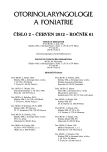The Use of CT Navigation in Head Surgery
Authors:
D. Kovář 1,2; P. Fundová 1; M. Navara 1; Z. Voldřich 1
Authors‘ workplace:
Klinika ORL 3. LF UK a ÚVN Praha, přednosta kliniky MUDr. M. Navara, Ph. D.
1; Katedra válečné chirurgie FVZ UO, Hradec Králové, vedoucí katedry doc. MUDr. L. Klein, CSc.
2
Published in:
Otorinolaryngol Foniatr, 61, 2012, No. 2, pp. 100-103.
Category:
Original Article
Overview
CT navigation is an instrumental method for the determination of precise position of anatomical structures during surgery based on computer assisted preoperative CT images and consequent registration. In the course of surgery the surgeon is thereby provided with precisely localized anatomical points and also the position of the tool itself in 3D images and in 3 CT planes. The system of optical navigation Treon Plus of the Medtronic Company is used at the ORL Clinic of 3rd Medical Faculty, Charles University and Central Military Hospital Prague. Since 1st January, 2007 till 31st December, 2009, 141 patients have been operated on giving 257 interventions. These patients underwent 81 primary surgeries of paranasal sinuses, 46 revision surgeries of the same localization, seven surgical interventions after injuries and seven tumors. This kind of navigation was examined with MR fusion in order to determine the borders of extensive tumor of the tongue. In this cohort of patients the authors have not detected per- or postoperative complications. The advantage of the present CT navigation lies in the possibility of more extensive radicality, precision, but also higher consideration for the adjacent organs. The contribution is a part of project dealing with defense research of the Ministry of Defense 0801 8 8030.
Key words:
CT navigation, optical system, paranasal sinuses, anatomical points.
Sources
1. Al-Swiahb, J. N., Al Dousary, S. H.: Computer-aided endoscopic sinus surgery: a retrospective comparative study. Ann. Saudi Med., 30, 2010, 2, s.149-152.
2. Beumer, H. W., Puscas, L.: Computer modeling and navigation in maxillofacial surgery. Curr. Opin. Otolaryngol. Head Neck Surg., 17, 2009, 4, s. 270-273.
3. Cigánek, L., Voldřich, Z., Lešták, J.: Diplopie u zlomenin spodiny očnice. Čs. Oftal., 46, 1990, 2, 139-144.
4. Collyer, J.: Stereotactic navigation in oral and maxillofacial surgery. Br. J. Oral Maxillofac. Surg., 48, 2010, 2, s. 79-83.
5. Gunkel, A. R., Freysinger, W., Thumfart, W. F., Pototschnig, C.: Complete sphenoethmoidectomy and computer-assisted surgery. Acta Otorhinolaryngol Belg., 49, 1995, 3, s. 257-261.
6. Gunkel, A. R., Freysinger, W., Thumfart, W. F.: Experience with various 3-dimensional navigation systems in head and neck surgery. Arch. Otolaryngol Head Neck Surg., 126, 2000, 3, s. 390-395.
7. Hrušák, D., Jambura, J., Hauer, L.: Zlomeniny spodiny očnice (Statistika). Čes. Stomat., 110, 2010, 5, s. 104-108.
8. Chiu, A. G., Vaughan, W. C.: Revision endoscopic frontal sinus Sumery with surgical navigation. Otolaryngol. Head Neck Surg., 130, 2004, 3, s. 312-318.
9. Chrobok, V., Vokurka, J., Čelakovský, P., Růžička, J., Juran, J.: Zlomeniny očnice a jejich vliv na postavení, polohu a pohyblivost očního bulbu. Choroby hlavy a krku, 7, 1998, 1, s. 5-12.
10. Javer, A. R., Genoway, K. A.: Patient quality of life improvements with and without computer assistance in sinus surgery: outcomes study. J. Otolaryngol., 35, 2006, 6, s. 373-379.
11. Kulich, R., Sičák, M., Rác, P.: Využitie CT a MRI navigácie v otorinolaryngológii. 2. Slovensko-český otorinolaryngologický kongres, 27.-30. 6. 2007, Piešťany, kniha súhrnov, s. 30.
12. Lukáš, J., Diblík, P., Voska, P.: Poranění obličeje z pohledu otorinolaryngologa, oftalmologa a maxilofaciálního chirurga. Grada Publishing, 2001.
13. Mueller, S. A., Caversaccio, M.: Outcome of computer-assisted surgery in patiens with chronic rhinosinusitis. J. Laryngál. Otol., 124, 2010, 5, s. 500-504.
14. Otradovec, J., Šafář, S., Frengl, Z.: Hydraulické zlomeniny očnice. Čs. Oftal, 39, 1983, 4, s. 223-225.
15. Pham, A. M., Rafii, A. A., Metzger, M. C., Jamali, A., Strong, E. B.: Computer modeling and intraoperative navigation in maxillofacial surgery. Otolaryngol. Head Neck Surg., 137, 2007, 4, s. 624-631.
16. Švec, V., Jirava, E.: K výskytu a chirurgické léčbě zlomenin očnice. Čs. Oftal., 39, 1983, 4, s. 220-222.
17. Tabaee, A., Hsu, A. K., Shrime, M. G., Rickert, S., Close, L. G.: Quality of life and complications following image-guided endoscopic sinus surgery. Otolaryngol. Head Neck Surg., 135, 2006, 1, s. 76-80.
18. Tschopp, K. P., Thomaser, E. G.: Outcome of functional endonasal sinus surgery with and without CT-navigation. Rhinology, 46, 2008, 2, s. 116-120.
19. Vokurka, J.: Počítačem navigované operace v rinochirurgii. Otorinolaryng. a Foniat. /Prague/, 53, 2004, 3, s. 127-131.
20. Voldřich, Z.: Použití některých polymerů v otolaryngologii. Doktorská dizertační práce, Praha, 1987.
21. Voldřich, Z., Cigánek, L., Kozák, J., Sobota, J.: Chirurgické řešení zlomenin spodiny očnice pomocí polymerních materiálů. Čs. Otolaryng., 32, 1983, 6, s. 332-339.
Labels
Audiology Paediatric ENT ENT (Otorhinolaryngology)Article was published in
Otorhinolaryngology and Phoniatrics

2012 Issue 2
Most read in this issue
- Erythema Multiforme in ENT
- Extranodal NK/T Cell Lymphoma, Nasal Type - an Unusual Cause of Unilateral Nasal Obstruction
- Present View of Adenotomy a Tonsillectomy in the Czech Republic (a questionnaire study)
- Immediate Revision in Patients with Bilateral Recurrent Laryngeal Nerve Palsy after Operation of Thyroid Gland and Parathyroid Glands
